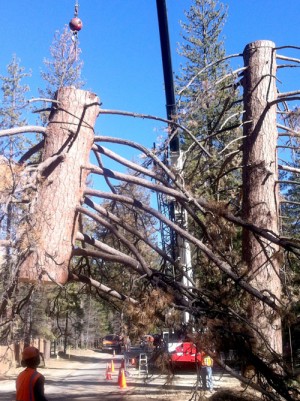
Photos courtesy of Jacobus Pino, Pino Tree Service
While the Hill water districts must manage the diminishing water supplies, one companion of the drought conditions is the native bark beetle, whose presence is much more apparent during dry times.
“Typically, all the different tree killing beetles will start to thrive when trees are stressed with drought or other factors,” said Kevin Turner, with University of California, Riverside. Turner’s work is focused on the golden spotted oak borer now, but he is the former Cal Fire Division Chief on the Hill.
Dave Simmons, Southern California Edison’s manager of the bark beetle project, reported an alarming number of dead and dying pines on the Hill and the San Bernardino Mountains.

“We’re not seeing the cold weather,” Simmons said. “So there’s a lot of bark beetle activity.”
“We’ve been working non-stop for the last three months,” said Jacobus Pino of Idyllwild and owner of Pino Tree Service. He has had to hire on more crews to respond to Edison’s need to take trees down before they fall across power lines and possibly cause a major fire.
Just last week, Pino was busy taking down a 140-foot tree on Tollgate and several trees along Village Center Drive near Strawberry Creek the next day.
Mountain Community Fire Safe Council project managers Pat Boss and Don Patterson, who spend significant time outside on the Hill, both said they are seeing more and more stressed trees. The Garner Valley area appears more vulnerable this time, they said.
“Unfortunately, the lack of water for 13 or more months has left the trees more vulnerable to the bark beetle,” said Chief Gregg Bratcher, the current RCFD unit forester.
Technically, the bark beetle is not the only insect enemy of pines. The Ips beetle and the western pine beetle can be found in local forests. Each has its own favorite target area on the pine. For example, the Ips beetles attack near the tree’s top and the bark beetle is found lower on the tree, near the middle.
The tree’s normal defense is to cover the attacker with sap and force or pitch it out. But the lack of water inhibits the tree’s ability to produce the protective sap, which is the reason that the pests’ presence is more noticeable during droughts.
The Riverside County Fire Department still has grant money available for removing dead and dying trees, Bratcher said. The County can provide 75 percent of the cost and the property owner will pay 25 percent. Anyone interested in help can reach Bratcher at 659-3337.
For trees that may be endangering power lines, Simmons suggested calling his office at (909) 307-6828.
And the GSOB continues to attack local oaks. Bratcher said the number of confirmed attacks now totals 29. Call the Fire Safe Council at 659-6208 to request an inspection.













